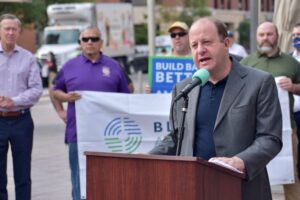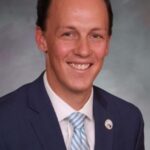Widgetized Section
Go to Admin » Appearance » Widgets » and move Gabfire Widget: Social into that MastheadOverlay zone
New P3 state office seen as key to solving Colorado housing crisis, including at Dowd Junction
Colorado has a housing problem. As a whole, the state is short 127,000 housing units, the seventh worst gap in the nation, according to a recent analysis.
Gov. Jared Polis and lawmakers know this. In order to address state housing needs, they’ve had to get creative with solutions, and it starts with public-private partnerships.

Public-private partnerships are long-term agreements between the government and a private partner — in this case, housing contractors — where the private partner delivers public services using funds from the government. Essentially, the state will provide contractors with the land it owns to build more housing.
In Colorado, these agreements are sorted through the Public-Private Partnership Collaboration Unit, or P3, an office within the Department of Personnel and Administration.
“What we’ve been trying to do is get the office up and running — hire a director, put into place the office’s goals and objectives and identifying properties that might fall under the scope of that statute,” said P3 communications manager Doug Platt, referring to the law that created the office last year.
P3’s main objective is to plan, operate and implement private-public partnerships throughout the state. The office is still in its infancy. The first test of its ability to broker transactions is in the Burnham Yard Transportation Study. Begun in October 2022, the study seeks to improve freight and passenger rail through the area west of the Lincoln Park neighborhood in Denver and will recommend track layout alternatives while maintaining operations for Front Range Passenger Rail. P3 is looking for a vendor representative for the project.
As for housing, there are 55 vacant state-owned parcels across Colorado that could be used for affordable housing development, including a Colorado Department of Transportation parcel near Dowd Junction in Eagle County. Ranging from as little as two acres to more than 150 acres, most parcels lie in the Front Range with other available lots located as far south as Trinidad and as far west as Grand Junction. P3 has the jurisdiction to have developers build on this land, but there are caveats.
“I can’t say that all of them will be subjected to P3 development,” said Platt. “There’ll be a number of components as to whether or not it’s developable (and) for what purposes.”
Such components include the land size and expectations of local jurisdictions, as well as stakeholders’ influence on the project.
But before any of that happens and in order for P3 to pull its weight in addressing housing issues, it needs more funding, which the Colorado Legislature has begun to address.
One step at a time
In January, Senate Bill 23-1, which would transfer $13 million to the Unused State-Owned Real Property Fund to support public-private partnerships, passed in the Local Government & Housing Committee. The bill is sponsored by state Sen. Dylan Roberts, D-Avon.

The bill specifically gives power to P3 to broker real-estate transactions between the state and developers. Should SB-1 pass both chambers of the Legislature and be signed by the governor, the real work would begin on providing more housing for Coloradans.
Proponents of the bill, such as Bruce Eisenhauer, the legislative liaison of the Department of Local Affairs, have used Denver’s Capitol Square Apartments as an example of what public-private partnerships can do to increase housing units.
Located on the corner of 13th Avenue and Sherman Street, the project created 103 new homes for people earning between 30% to 80% of the area median income. The $33.9 million project garnered funding from a variety of groups, including over $1.5 million from the City and County of Denver, and other donations from the Colorado Department of Local Affairs and the Colorado Housing & Finance Authority.
“This is just an example of what can be done using this model,” Eisenhauer said in testimony to a committee in January.
Should the bill pass, the $13 million would serve as a soft start to build a few projects and test the overall concept. Where and when these places will be developed is currently unknown.
Polis made housing a top priority in his State of the State address in January. He argued that meeting the state’s housing needs “means we need more flexible zoning to allow more housing, streamlined regulations that cut through red tape, expedited approval processes for projects like modular housing, sustainable development and more building in transit-oriented communities.”
Cities and counties traditionally set their own land use policies, meaning that the promises the governor made in his address could be hard to keep. But P3 is attempting to lead these sorts of discussions, starting with facilitating collaboration between the state’s public entities and private partners while enabling access to private capital.
In addition to Polis’ ambitions, candidates in the Denver mayoral race have had to answer for their plans for increasing affordable housing, most recently at a forum led by unhoused Denverites.
As for whether potential housing will be sectioned off to workforce housing, which targets middle-income workers earning between 60% to 120% of the area median income on average, or affordable housing, which targets workers earning 60% or less of the median income on average, Platt said the office is keeping its options open but that it’s still too early to tell, depending on the vacant parcel and local expectations.
“I don’t think that limits us but as we move through the projects and proposals, that will become more evident,” he said.
For now, P3 continues to research which properties could be developed as affordable housing and find contractors who are able to complete the job.
“We’re taking it one step at a time,” Platt said. “As we develop the program and we identify more constituents and all those components that are going into these developments — those will make themselves apparent as we move through.”
Editor’s note: This story first appeared on Colorado Newsline, which is part of States Newsroom, a network of news bureaus supported by grants and a coalition of donors as a 501c(3) public charity. Colorado Newsline maintains editorial independence. Contact Editor Quentin Young for questions: info@coloradonewsline.com. Follow Colorado Newsline on Facebook and Twitter.


